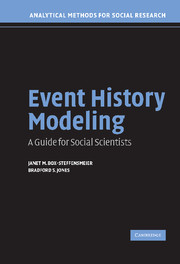Book contents
- Frontmatter
- Contents
- List of Figures
- List of Tables
- Preface
- 1 Event History and Social Science
- 2 The Logic of Event History Analysis
- 3 Parametric Models for Single-Spell Duration Data
- 4 The Cox Proportional Hazards Model
- 5 Models for Discrete Data
- 6 Issues in Model Selection
- 7 Inclusion of Time-Varying Covariates
- 8 Diagnostic Methods for the Event History Model
- 9 Some Modeling Strategies for Unobserved Heterogeneity
- 10 Models for Multiple Events
- 11 The Social Sciences and Event History
- Appendix: Software for Event History Analysis
- References
- Index
11 - The Social Sciences and Event History
Published online by Cambridge University Press: 05 September 2012
- Frontmatter
- Contents
- List of Figures
- List of Tables
- Preface
- 1 Event History and Social Science
- 2 The Logic of Event History Analysis
- 3 Parametric Models for Single-Spell Duration Data
- 4 The Cox Proportional Hazards Model
- 5 Models for Discrete Data
- 6 Issues in Model Selection
- 7 Inclusion of Time-Varying Covariates
- 8 Diagnostic Methods for the Event History Model
- 9 Some Modeling Strategies for Unobserved Heterogeneity
- 10 Models for Multiple Events
- 11 The Social Sciences and Event History
- Appendix: Software for Event History Analysis
- References
- Index
Summary
It has been our intent to demonstrate how the multitude of methods discussed in this book are naturally relevant for social science analysis. We have stressed throughout that many of the problems, hypotheses, and theories underlying social science research have at their core an implicit or explicit interest in the notions of timing and social change. Event history models are ideally suited for such problems. Given the kinds of questions social scientists ask and the applicability of event history analysis, the models we have considered would seem to have great import for analysis.
We have presented a number of examples of event history analysis with social science data that highlight the interest in both the occurrence of an event and the history leading up to the event. Moving from a focus solely on whether an event occurred to additionally considering when an event occurred can result in much greater analytical leverage on the problem at hand. Similarly, moving from the study of how often an event occurs, for example through the use of event count models, to how often and when an event occurred, for example through the use of a repeated events model, can have analytical payoffs.
Based on the interest in social science theory regarding longitudinal processes, and given the inherent problems of traditional models in handling event history data, we hope readers recognize that event history models are a valuable method for addressing substantive social science problems.
- Type
- Chapter
- Information
- Event History ModelingA Guide for Social Scientists, pp. 183 - 198Publisher: Cambridge University PressPrint publication year: 2004

